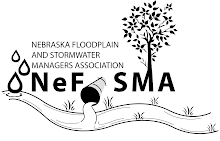Low Impact Developments: Implementation and Monitoring in Omaha, Nebraska, Kellan Strauch, Hydrologist, USGS Nebraska Water Science Center; and Kent Holm, Environmental Services Director, Douglas County
Learning objectives: There are many agencies and firms involved in stormwater BMPs in the Omaha metro and this presentation will strengthen that network of expertise by providing an understanding of BMPs being implemented by Douglas County. This presentation will also provide a framework for monitoring the effectiveness of bioretention cells, something that is not routinely done.
Abstract:
This presentation will provide an overview of low impact development projects that Douglas County is currently implementing to reduce the amount of water entering the combined sewer overflows in Omaha, Nebraska. It will focus on a monitoring study in progress at two recently installed bioretention cells at the Douglas County Health Center and Eastern Nebraska Office on Aging. The presentation will discuss the methods of the study, instrumentation being used, and preliminary results. While bioretention cells have been utilized for a number of years, questions still exist about their effectiveness. To validate “green” infrastructure best management practices, monitoring data are needed.
This presentation will provide an overview of low impact development projects that Douglas County is currently implementing to reduce the amount of water entering the combined sewer overflows in Omaha, Nebraska. It will focus on a monitoring study in progress at two recently installed bioretention cells at the Douglas County Health Center and Eastern Nebraska Office on Aging. The presentation will discuss the methods of the study, instrumentation being used, and preliminary results. While bioretention cells have been utilized for a number of years, questions still exist about their effectiveness. To validate “green” infrastructure best management practices, monitoring data are needed.
The USGS and Douglas County Nebraska Environment Services are measuring the water budget at two bioretention cells in Omaha, NE to evaluate their effectiveness at reducing stormwater outflows.
The water balance components of the cells that are being considered are: flow into the cell, precipitation, evapotranspiration, infiltration, and flow out of the cell. A 9-inch Parshall flume is used to measure inflow. A weather station at each site measures precipitation and meteorological data that will be used to calculate evapotranspiration. Infiltration is estimated using soil-matrix potential and water content relationships. Outflow is estimated by measuring the depth of the water above the outlet pipe. Data collection began in December 2010.
The water balance components of the cells that are being considered are: flow into the cell, precipitation, evapotranspiration, infiltration, and flow out of the cell. A 9-inch Parshall flume is used to measure inflow. A weather station at each site measures precipitation and meteorological data that will be used to calculate evapotranspiration. Infiltration is estimated using soil-matrix potential and water content relationships. Outflow is estimated by measuring the depth of the water above the outlet pipe. Data collection began in December 2010.
Basic water-quality monitoring is also being done in the cells. Auto-samplers will collect flow-weighted samples and are analyzed for E-coli, suspended sediment, and nutrients. Sensors are installed at bioretention cell inlets to measure water temperature and conductance.


No comments:
Post a Comment